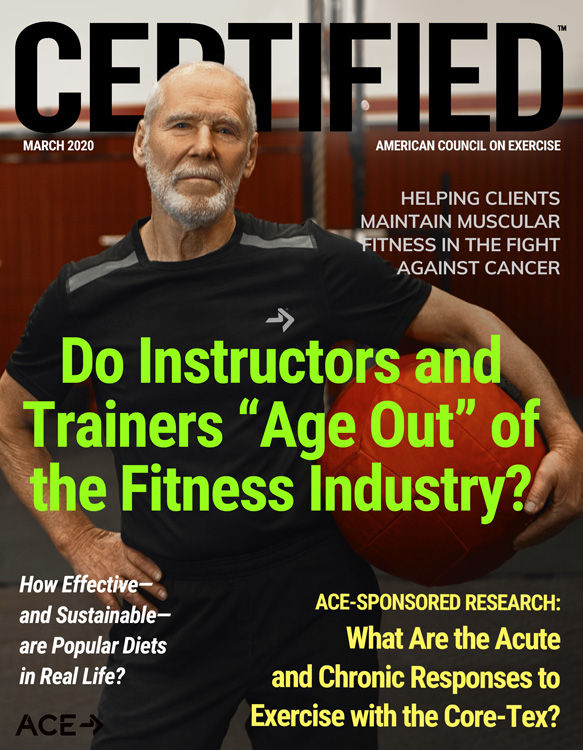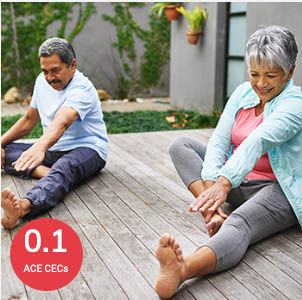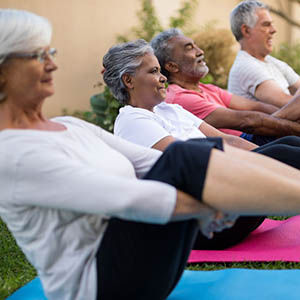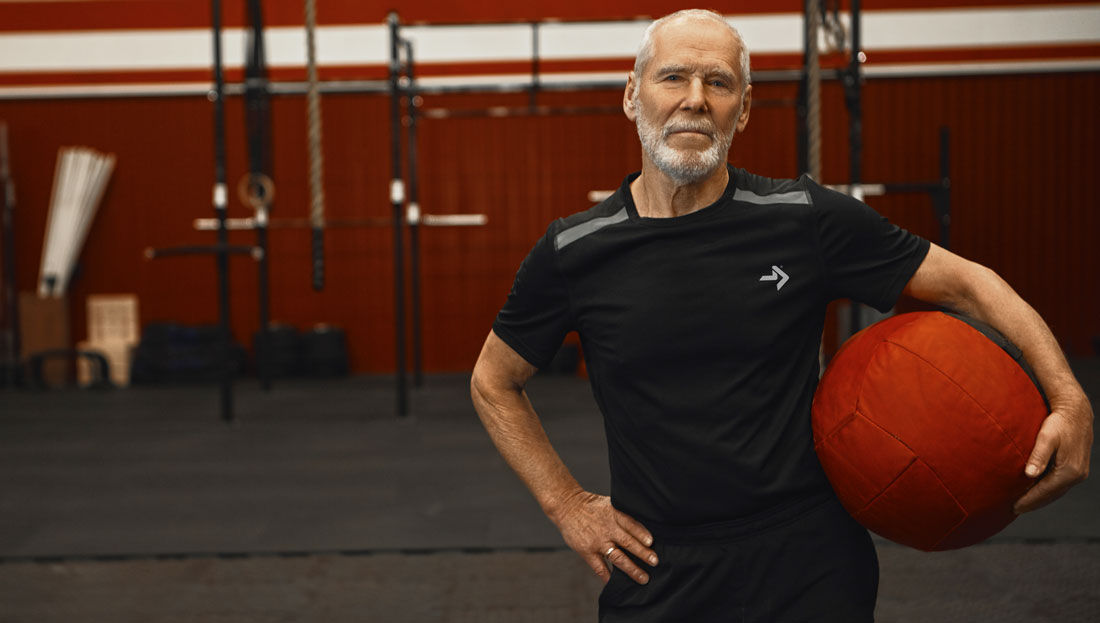
If you’ve worked as a health and exercise professional for at least a couple of decades, you’ve been fortunate enough to mature along with the fitness industry, literally! As you’ve grown older, perhaps your professional goals have advanced as well. Along the way, you might have also started attracting an older clientele (whatever “older” means to you!). Or, perhaps certain clients/participants now perceive you as an older trainer/instructor (whatever “older” means to them!).
Does a trainer in his or her 50s or 60s have the same appeal to a 25-year-old client/participant as a trainer or instructor in his or her 20s, 30s or 40s? Is it possible that trainers and instructors eventually “age out” with certain younger clients or class types?
These are timely questions, considering the average age for a club member is 38, and Millennials (approximately ages 19 to 38) represent 33% of total club membership, according to a 2019 IHRSA report. That’s the largest generational segment in clubs at the moment.
At 24%, Gen Xers (approximately ages 39 to 54) are the second most represented generation in health clubs, followed closely by Baby Boomers (approximately ages 55 to 74) at 22% (IHRSA, 2019).
With these stats in mind, this article examines what it means to mature in the fitness profession and whether fitness consumers care that much about chronological age when it comes to seeking services.
Ageism in the Fitness Industry
Ageism exists in larger society, so it’s no surprise to see it in the fitness industry. In fact, the industry’s emphasis on intensity and aesthetics might render ageism even more apparent than in many other sectors.
Colin Milner, Vancouver, B.C.−based CEO of the International Council on Active Aging and founder of the active-aging industry in North America, believes the fitness industry has been ageist since its inception. “If we were not ageist, we would be creating more products, programs and facilities that are inclusive, instead of exclusive to the already fit,” he says. “We would focus on function instead of age to describe programs.”
Milner makes a good point: The industry tends to relegate over-60 exercisers to programs named for that demographic (e.g., “Senior Fit” or “Golden Years Yoga”) rather than for training type or outcome (which could benefit any age category). In reality, many middle-aged and older clients might do just fine in a class marketed to a younger audience and many young people would benefit from content found in “older adult” programming.
How does this divide affect trainers and instructors? First, it categorizes fitness by age in a way that’s not always appropriate: Younger people exercise in this class and older people exercise in that class. Health and exercise professionals are not immune to these stereotypes.
“There is room enough for fitness professionals of all ages, yet there are certain settings (primarily glitzy club environments) that do project a somewhat intimidating stance to older trainers,” says Cathy Richards, MA, an exercise physiologist, wellness coach and owner of Inspiring Vitality in Germantown, Md. “I’ve seen younger personnel who hire staff at fitness clubs treat older fitness professionals (even those ‘only’ in their 40s or 50s) in a dismissive way, not giving them an audition even [if they have] an extensive résumé. Or, they assume they wouldn’t be able to keep up with a younger class or clientele [or keep them] happy.” (Of course, exercise professionals can challenge this assumption—read on.)
Secondly, the industry has forever promoted a youthful fitness ideal: chiseled bodies fearlessly crushing it in high-intensity workouts. Although the industry has been shifting to more inclusive advertising of late, we see it mostly in terms of client/member depictions. Trainers and instructors are still typically portrayed as relatively young.
“Despite the notion that we grow wiser as we get older, there is still the viewpoint that the younger person with the six-pack abs and sexy butt ‘knows’ more about getting in shape because they’ve got a great body,” says Summer N. Sides, MS, who is certified in personal training, group fitness, yoga and Pilates. She’s the founder of and an educator for GXunited.com in Greensboro, N.C.
A Matter of Context
When age is involved, what constitutes a “great body” relies somewhat on context—as does ageism in general. For example, the industry as a whole travels in different “circles,” so it’s possible that those caught up in Peloton culture might observe trainer age quite differently than those attending/working for a family-focused community center.
Lynne Skilton-Hayes is the Fitness Program Supervisor for the University of Guelph’s Athletic program in Ontario, Canada. “In the presenting world,” she says, “the icons are the most revered, in my opinion. They are looked at as experienced, not old.” However, conferences and presenters make up only a small slice of the industry.
Depending on their interests, consumers and many trainers are probably most guided and influenced by their local gyms, trainers (online or offline), apps and/or Instagram. “When you look at social media and influencers, they are young for the most part, and in places, are replacing those that are older/more mature and more experienced,” says Skilton-Hayes.
Naturally, younger generations have always eventually replaced older generations, in any occupation. And as part of the process, Kevin Mullins—Director of Product Development for The St. James, a sports, wellness and active entertainment brand based in Springfield, Va.—points out that ageism can go both ways. “Younger people experience it in fields such as medicine and law. They are judged for not being ‘old and wise,’” he says. “Older individuals feel the same heat in fields in which energy and relationships rule.” With that in mind, is it possible that health and exercise professionals are just inherently prone to “age out” of the energetic fitness field?
Aging Out of the Fitness Industry
Ask the average trainer/instructor over 40 if the industry has an “aging out” problem and they might say no. As long as trainers/instructors are great at what they do and stay educated and up to date, aging out isn’t a concern. But does the average under-40 client/participant share this viewpoint?
Mullins, a presenter and personal trainer in his early 30s, thinks not. He believes “aging out” happens with certain clients and classes because people feel affinity through similarity. “Trainers have a plus-or-minus-seven rule, in my eyes. You are most well received when you are within seven years of your target market,” he says. “Thankfully, the industry ages up and down as needed. Older coaches can find older clients who fall in the plus-or-minus-seven range just as younger coaches can.”
“I will gravitate more toward individuals who are within a relatively close age range to me (plus or minus 8 to 10 years),” says Sides, who is in her mid-30s. “If I’m looking for a trainer or instructor, I want someone I can relate to. I want that person who I can talk to about my current life situations.” As a rule, people prefer peer interactions, and the fitness space is no exception.
Where does that leave older trainers/instructors who enjoy teaching high-intensity programs typically populated by a younger clientele? Perhaps it’s a matter of personality over age. If you can deliver what clients want, a 20- or 30-year age gap technically shouldn’t matter.
Inside and Outside Your Own Age Demographic
“In fitness, especially group exercise, the ability to become singular with your crowd is what elevates a good class to a great experience,” says Mullins. “Being able to match your energy, language and music to your population is 70% of the popularity scale.” He says the key to success is realizing that your target market—which often are the people most like you—will always respond best.
Following that logic, you’d think demand specifically for middle-aged and older trainers/instructors would be booming, with multiple generations over 40 needing health and fitness guidance these days. Yet, the industry mostly caters to a youth market.
Along those lines, Sides suggests it’s possible that some older clients actually prefer much younger trainers/instructors because it makes them feel younger. For others, it’s conceivable that an obvious generation gap would have the opposite effect.
Perhaps gym or class culture is what sways opinion most. As an example, take the university where Skilton-Hayes works. Most of the clientele there are 20-something university students, yet the most popular trainers and instructors are older than that, according to Skilton-Hayes, whose managerial responsibilities include connecting clients to trainers.
“I have several trainers who work with younger clients. In fact, they are requested many times,” says Skilton-Hayes. “When I ask whether a client would prefer a student or a nonstudent trainer, 95% of the time, the answer is, ‘I don’t care, as long as they know what they are doing.’”
With Age Comes Experience…
If we judged trainers and instructors solely by their in-the-field experience and accumulated knowledge, those in their 40s, 50s, 60s and beyond might be the most accepted and admired. Sometimes they are. But experience is only one variable among many that might influence someone to seek out one trainer/instructor over another.
Says Milner, “You’d think a 20-year-old would want to embrace the experience and knowledge that an older trainer in his or her 60s has to offer. Yet [many] don’t.”
“Honestly, not all clients care what your qualifications are,” says Mullins. “They only care if you can help someone like them. Being older and more qualified only matters if you can put yourself back into a 20-year-old’s shoes and care about the things that they care about. In the same way, many younger trainers can’t relate to older clients. The goals are just too different.”
Richards sees it as a balance between experience and rapport. “In my opinion, most consumers, at any age, aren’t necessarily looking for the trainer with the absolute most experience,” she says. Rather, they want someone with enough experience to meet whatever bar they have set for themselves. For some clients, a 30-year-old trainer with 10 years’ experience might be comparable to a 50-year-old trainer with 30 years’ experience.
In other words, experience matters, but perhaps there’s a ceiling to its importance.
Additionally, experience could become disadvantageous at some point. That is, the more leveled-up a health and exercise professional’s experience and expertise gets (which happens primarily with age), the more they can and should charge for their services. However, in an industry where low compensation is an ongoing problem, a demand for higher pay might work against older trainers and instructors, contributing to their “aging out” in the industry.
“As I’ve gotten older and gained more experience (I’m only 36, but started when I was 18), it’s become harder to find jobs,” says Sides. “Companies want younger individuals because they can pay them less. More experience equals higher pay, and that is a difficult thing for companies to consider. Thus, hiring the [younger professionals] means their bottom line stays low and they are on trend with marketing standards.”
Experience Drives Results
In the end, clients and participants want to feel successful, and they want results. Learning how to hit that sweet spot with clients/participants comes with experience. “If you are the expert, there is value in that,” says Milner. “If your clients get great results, there is value in that.”
“I am 50 and still teach every day on our schedule,” says Skilton-Hayes, who has 25 years of experience in the industry. “My classes are some of the busiest, and same goes for the other ‘veteran’ instructors. Feedback from students is that they love the passion and energy we bring. They appreciate how much we educate in our classes and how we are an awesome example of fitness at any age.”
Skilton-Hayes credits this positive reception to relatability across age groups. “Our more mature instructors have perfected the art of adapting to our audience,” she says. “This can be through conversations you have with participants before and after class, the music you play, the programs you offer, the references you use in class, etc.”
Relevancy at Any Age
Everyone ages. Your ability to avoid potentially “aging out” in the industry might hinge mostly on your willingness to remain relevant in your career—regardless of the classes you teach or age demographic you choose to serve. “Trainers and instructors will age out if they do not have a committed approach and mindset to staying current with education,” says Skilton-Hayes.
Education, yes. However, your biggest strength toward career relevancy might be through human connection. “People of all ages want to be seen as individuals and not just part of a demographic,” says Richards. “Our personalities and rapport are going to vary even when age is a constant, so it can be helpful not to immediately jump to age as the biggest differentiator.”
Reaching younger audiences, if that’s your goal, includes receptivity to current cultural touch points, such as social media, technology and entertainment. “A trainer in the later years of his or her career needs to be up-to-date with pop culture and remember what it is like to be 20 or 30,” says Mullins. Embracing your current age and style doesn’t mean you can’t still relate to those who are younger or older than you.
“Older trainers who [work] with younger clients will do what it takes to stay relevant to the younger clients for whom they are a good match,” says Richards. “At age 53, I have had several clients within the past year in their mid-20s who have been very happy with my services and rapport with them because their goals were consistent with my expertise and our personalities were a good match. On the other hand, there are others in the younger demographic that have workout needs or class types that I haven’t kept up with and I would be doing them a disservice if I pursued work with them.”
Says Sides, “In many ways, as we age in the world of fitness, our own methods of training, styles of classes that we’ll teach, and ideologies also change. I’m not sure if this is aging out, or it’s changing as we age.”
Fitness Across Generations
Age-driven tendencies aren’t necessarily a bad thing, says Richards. But we would do well as an industry to avoid pandering to stereotypes. “We need to reinforce the message of health,” says Milner, “and become accessible for all, staffing [fitness] centers with people as diverse as our members.”
Then again, a new, younger generation might exercise in ways that don’t involve brick and mortar at all. Whatever the backdrop, health and exercise professionals who prove their relevancy with their preferred audience and format likely won’t have to worry about aging out.
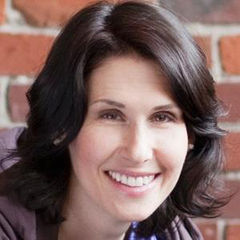




 by
by 